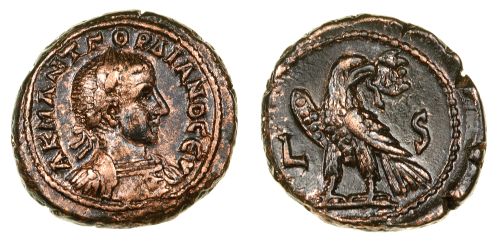Roman Egypt
Ptolemaic Egypt was gradually absorbed into the Roman Empire between the days of the First Triumvirate in Rome and the change in rule from Ptolemy XIII to his sister-wife Cleopatra VII in Egypt, in 47 BCE, and the suicides of Marcus Antonius and Cleopatra VII in 30 BCE. This was related to the transition from the Roman Republic to the Roman Empire, traditionally marked by the change from the final triumvir of the Second Triumvirate, Octavian, into the first Roman Emperor, Augustus, in 27 BCE. Thus Egypt was never truly part of the Roman Republican territorial expanse, but was part of the Roman Empire from its beginning with the first Emperor, Augustus, in 27 BCE.
With the exception of a few rebels in the area, and a brief amount of time occupied by first the Palmyrene Empire in 270-272 CE, then the Sasanian Empire in 618-628 CE, Egypt remained part of the Roman Empire until the Caliphal conquests secured all of Egypt in 646 CE. Egypt was a vital province to the Roman Empire, being – alongside Africa Proconsularis (modern Tunisia) and during some periods, Sicily – one of its ‘bread baskets’, and source of the annona, a tax in kind focussed on taking grain from fertile regions to major cities of the Empire.
Egypt and coinage
This status of Egypt in relation to the Empire is something that was reflected in the coinage of the province. Ancient Egypt had never produced or used coinage, and it was only with the invasion of Alexander III of Macedon (Alexander the Great) in 332 BCE, and the subsequent rule of his general, Ptolemy I Soter, and the latter’s descendants, that coinage was introduced to and produced in Egypt. Even so, archaeological evidence suggests that coin usage never really took off in Egypt outside of major cities, such as Alexandria, until around the eighth century CE, during the later days of the Umayyad Caliphate.
The coinage of Ptolemaic Egypt followed the denominational pattern of Macedonian coinage, which derived from earlier Greek models. In this system, the silver tetradrachm (4 drachma) was the main unit, with denominations being related in size – so a drachm was one quarter of a tetradrachm, for example. One mainstay of the imagery on Ptolemaic coinage, other than the stylised portrait of the ruler, was the so-called ‘Ptolemaic Eagle’.
By the time of Cleopatra VII, when Egypt was being absorbed into the Roman Republican territories, there were both Ptolemaic coins of Cleopatra (though they had a much lower silver content than during the days of her ancestor, Ptolemy I) and Roman Republican coins in Roman denominations, such as the denarius, which referenced Cleopatra as Queen of Egypt.
Arguably, one of the ways in which the Roman Empire was successful was by allowing a certain amount of autonomy to local elites. We tend now to think of Empires as nationalistic or racialised endeavours, but a much more accurate way to think of the Roman empire is as a parasitic empire of class and nobility – it left local kings, senates and other potentates in situ to continue ruling on behalf of the Roman Emperor. Again, this is something which can be seen through the coinage.
On the one hand, there are centralised Roman Imperial coins which show a Roman Emperor presenting a king to the personified version of a region. On the other hand, there was the dual system of Roman coinage, today referred to as the distinction between Roman Imperial coinage and Roman Provincial coinage.
Roman Provincial coinage
The coinage of the Roman Empire falls broadly into two categories: Roman imperial and Roman provincial. Roman imperial coinage is what is most commonly meant when people talk about ‘Roman coinage’; it is made in a formal central mint, such as Rome, Lugdunum, or Antioch, and can be gold, silver or base metal. Roman imperial coinage was made with the authority of the Roman emperor, and was broadly consistently produced during the empire. The coin legends were always in Latin.
Roman provincial coinage circulated ‘legally’ within the Roman Empire, but was produced with the authority of local senates, rulers, or temples. Roman Provincial coinage was almost always base metal, and the denominations varied according to the region they were produced in. The coin legends were in different local languages and scripts, but predominantly Greek, the lingua franca of the eastern half of the Empire, and where most provincial coinage was produced.
Roman provincial coinage was predominantly produced in the eastern half of the Empire because it had a stronger tradition of independent coinage than in the west, where pre-Roman coins had mainly been imitations of coins from the Greek world. As described above, this was very much the case for Egypt.
Roman Egyptian coinage
Roman Egyptian coinage followed the Ptolemaic model, except with a reduced number of denominations – almost exclusively the tetradrachm. The process of debasement (the lowering of the amount of precious metal in the coins) continued to such an extent, that we call these coins ‘billon’ (N.B. billon the alloy, not billion the number) – a mixture of silver and copper. The face of the Emperor replaced the face of the Ptolemaic Pharoah, and his titles were given in Greek, e.g. σεβαστος (sebastos) instead of augustus, or αυτοκρατωρ (autokrator) instead of imperator. The Ptolemaic eagle was still used widely, but other images were introduced, such as a personification of the city of Alexandria, the personification of the River Nile, the god Serapis, and other Egypt-specific images such as a canopic jar, or pair of jars.
This coinage continued to be produced until the system was reformed and provincial coinage was stopped under the Emperor Diocletian in 301 CE.
The Barber’s collection
All of the Barber’s 1,187 Roman Egyptian coins come through the collection of Philip Whitting, who became interested in the series toward the end of his life. This may be because it is only in recent years that the Roman Provincial coinage has received any great scholarly attention, and so were much cheaper to collect in the 1970s and 1980s. It may also be that they posed an interesting academic challenge to Whitting, who died before he was able to fully pursue it.
Visiting the collection online
Unfortunately, this section has not been catalogued for publication online, yet. We will update this space when it has.
Exhibitions
In 2010-2012, the exhibition Sacred and Profane: Treasure of Ancient Egypt, in collaboration with the Eton Myers collection, focussed on the the Roman Egyptian collection. The exhibition is no longer open.
Visiting the collection
To visit the Roman Egyptian collection, you will need to book an appointment to our Coin Study Room. Visit the dedicated page for details on arranging a visit for individuals looking to research (this includes both affiliated and independent scholars), or to book for a group visit for both schools and the general public.

